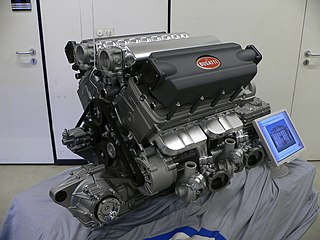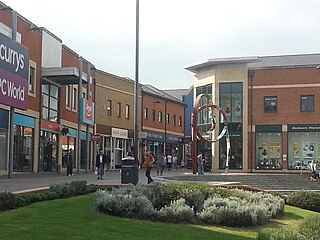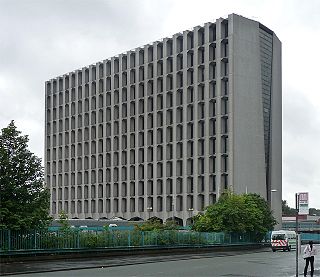This article needs additional citations for verification .(August 2020) |
The British Hydromechanics Research Association is a former government research association that supplies consulting engineering over fluid dynamics.
This article needs additional citations for verification .(August 2020) |
The British Hydromechanics Research Association is a former government research association that supplies consulting engineering over fluid dynamics.
It was formed on 20 September 1947 in Essex, under the Companies Act 1929 [1]
It had moved to Bedfordshire by the 1960s. In the 1970s it was known as BHRA Fluid Engineering.
Next door was the National Centre for Materials Handling, set up by the Ministry of Technology (MinTech), later known as the National Materials Handling Centre.
On 16 October 1989 it became a private consultancy. [2]
The BHRA conducted most of the research for the aerodynamics of British power station infrastructure in the 1960s, such as cooling towers.
In 1966 it designed an early Thames flood barrier. [3]
It developed early CFD software.
On Tuesday 21 June 1966, the new Bedfordshire laboratories were opened by Duke of Edinburgh. [4]
The organisation, Framatome BHR, is now in Cranfield in west Bedfordshire, near the M1.

Mechanical engineering is an engineering branch that combines engineering physics and mathematics principles with materials science, to design, analyze, manufacture, and maintain mechanical systems. It is one of the oldest and broadest of the engineering branches.

Didcot is a railway town and civil parish in the ceremonial county of Oxfordshire and the historic county of Berkshire. Didcot is 15 miles (24 km) south of Oxford, 10 miles (16 km) east of Wantage and 15 miles (24 km) north west of Reading. The town is noted for its railway heritage, Didcot station opening as a junction station on the Great Western Main Line in 1844. Today the town is known for the railway museum and power stations, and is the gateway town to the Science Vale: three large science and technology centres in the surrounding villages of Milton, Culham and Harwell.

The English Electric Company Limited (EE) was a British industrial manufacturer formed after the armistice of World War I by amalgamating five businesses which, during the war, had been making munitions, armaments and aeroplanes.

Magnox is a type of nuclear power/production reactor that was designed to run on natural uranium with graphite as the moderator and carbon dioxide gas as the heat exchange coolant. It belongs to the wider class of gas-cooled reactors. The name comes from the magnesium-aluminium alloy used to clad the fuel rods inside the reactor. Like most other "Generation I nuclear reactors", the Magnox was designed with the dual purpose of producing electrical power and plutonium-239 for the nascent nuclear weapons programme in Britain. The name refers specifically to the United Kingdom design but is sometimes used generically to refer to any similar reactor.

Cranfield University is a British postgraduate public research university specialising in science, engineering, design, technology and management. Cranfield was founded as the College of Aeronautics (CoA) in 1946. Through the 1950s and 1960s, the development of aircraft research led to growth and diversification into other areas such as manufacturing and management, and in 1967, to the founding of the Cranfield School of Management. In 1969, the College of Aeronautics was renamed the Cranfield Institute of Technology, was incorporated by royal charter, gained degree awarding powers, and became a university. In 1993, it adopted its current name.

A cooling tower is a device that rejects waste heat to the atmosphere through the cooling of a coolant stream, usually a water stream to a lower temperature. Cooling towers may either use the evaporation of water to remove process heat and cool the working fluid to near the wet-bulb air temperature or, in the case of dry cooling towers, rely solely on air to cool the working fluid to near the dry-bulb air temperature using radiators.
A magnetohydrodynamic generator is a magnetohydrodynamic converter that utilizes a Brayton cycle to transform thermal energy and kinetic energy directly into electricity. MHD generators are different from traditional electric generators in that they operate without moving parts to limit the upper temperature. They therefore have the highest known theoretical thermodynamic efficiency of any electrical generation method. MHD has been extensively developed as a topping cycle to increase the efficiency of electric generation, especially when burning coal or natural gas. The hot exhaust gas from an MHD generator can heat the boilers of a steam power plant, increasing overall efficiency.

A molten salt reactor (MSR) is a class of nuclear fission reactor in which the primary nuclear reactor coolant and/or the fuel is a molten salt mixture. Only two MSRs have ever operated, both research reactors in the United States. The 1950's Aircraft Reactor Experiment was primarily motivated by the compact size that the technique offers, while the 1960's Molten-Salt Reactor Experiment aimed to prove the concept of a nuclear power plant which implements a thorium fuel cycle in a breeder reactor. Increased research into Generation IV reactor designs began to renew interest in the technology, with multiple nations having projects, and as of September 2021, China is on the verge of starting its TMSR-LF1 thorium MSR.

Stewartby is a model village and civil parish in Bedfordshire, originally built for the workers of the London Brick Company. The village was designed and built to the plans of the company's architect Mr F W Walker, laid out on ‘Garden City’ principle, a later and more modern development than such better-known Victorian model villages as Saltaire. Started in 1926, Stewartby also is a later model than Woodlands which was first planned in 1905. The later retirement bungalow development of the 1950s and 1960s with the pavilion community centre in their midst was designed by the neo-Georgian architect Professor Sir Albert Richardson. Today, Stewartby parish also includes Kempston Hardwick.

Steam generators are heat exchangers used to convert water into steam from heat produced in a nuclear reactor core. They are used in pressurized water reactors (PWR) between the primary and secondary coolant loops.

Underfloor heating and cooling is a form of central heating and cooling that achieves indoor climate control for thermal comfort using hydronic or electrical heating elements embedded in a floor. Heating is achieved by conduction, radiation and convection. Use of underfloor heating dates back to the Neoglacial and Neolithic periods.

Little Barford Power Station is a gas-fired power station just north of the village of Little Barford in Bedfordshire, England. It lies just south of the A428 St Neots bypass and east of the Wyboston Leisure Park. The River Great Ouse runs alongside. It was formerly the site of two coal-fired power stations, now demolished. The station is operated by RWE.
BHRA may refer to:
J. L. Eve Construction was a civil engineering company from south London.

Hexagon Tower is a specialist science and technology facility located in Blackley, North Manchester, United Kingdom.

Bierrum is a British civil engineering and construction company, that has built all of Britain's concrete cooling towers at the country's power stations since 1965.

Donald Stuart (‘Don’) Miller is a British engineer and author of the industry standard ‘Internal Flow Systems’ text book.
Goldington Power Station was a 180 MW coal-fired electricity generating station located to the east of Bedford in Bedfordshire, England. It was commissioned in 1955 and closed in 1983 and was demolished during 1984–87.
The Aircraft Research Association (ARA) is an aerodynamics research institute in the north-west of Bedford.

Calder Hall Nuclear Power Station is a decommissioned and partly demolished Magnox nuclear power station at Sellafield in Cumbria in North West England. Calder Hall was the world's first full-scale commercial nuclear power station to enter operation, and was the sister plant to the Chapelcross plant in Scotland. Both were commissioned and originally operated by the United Kingdom Atomic Energy Authority. The primary purpose of both plants was to produce weapons-grade plutonium for the UK's nuclear weapons programme, but they also generated electrical power for the National Grid.